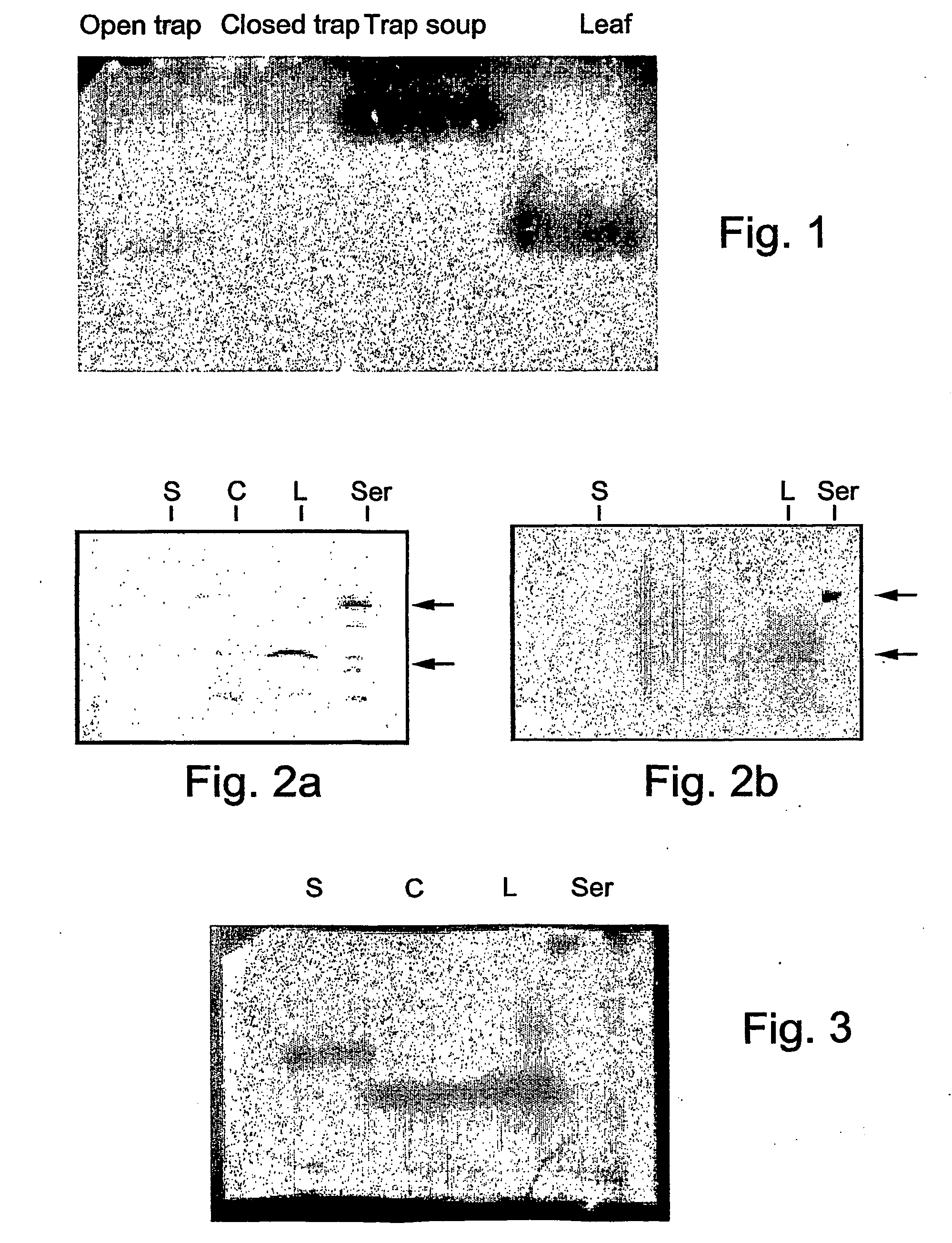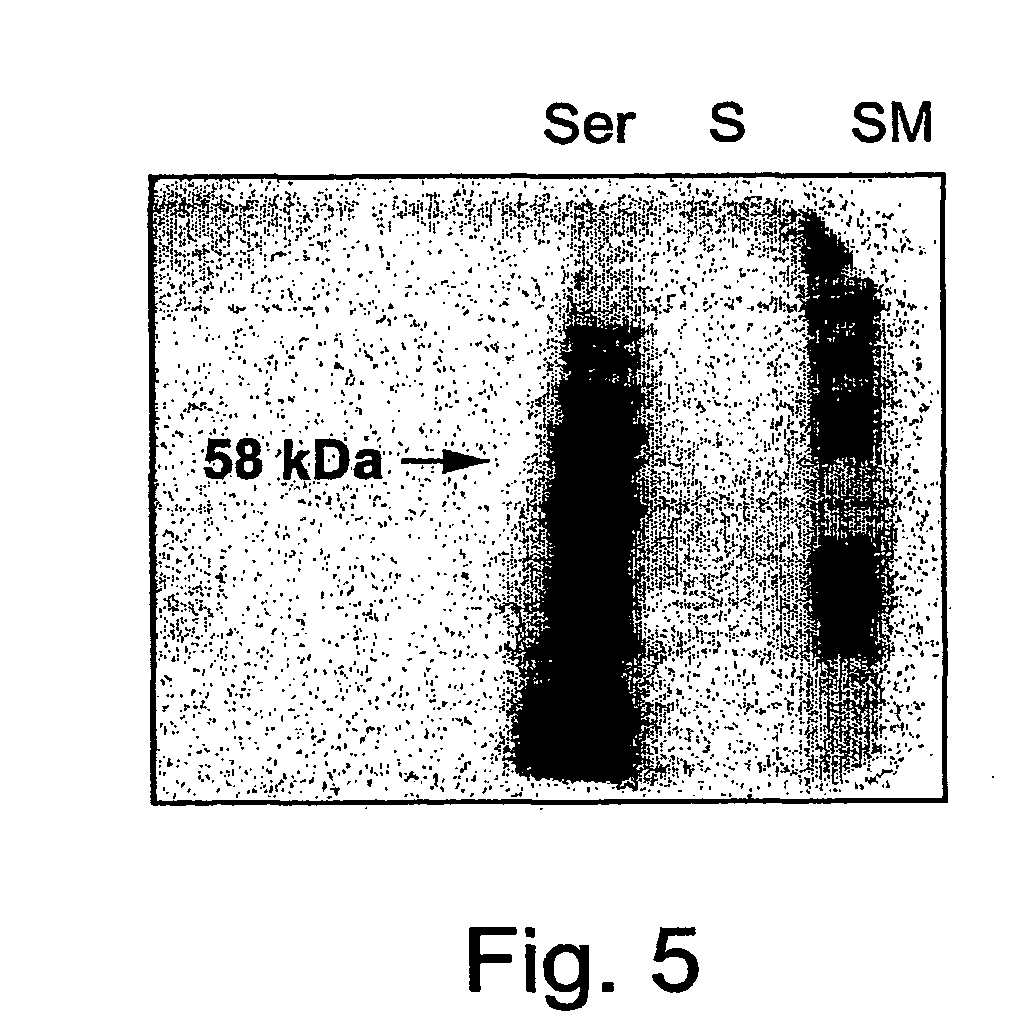Chitinases, derived from carnivorous plants polynucleotide sequences encoding thereof, and methods of isolating and using same
a carnivorous plant and chitinase technology, applied in the field of chitinases, can solve the problems of chitinases being isolated from carnivorous plants, unable to express yield, and total destruction of crops,
- Summary
- Abstract
- Description
- Claims
- Application Information
AI Technical Summary
Problems solved by technology
Method used
Image
Examples
example 1
Novel Chitinases from Different Nepenthes Tissues
[0283] The carnivorous plant Nepenthes kassiana is a pitcher plant which uses a passive method of attraction and entrapment of the prey (Owen and Lennon, 1999). The traps are modified epiascidiate leaves, in which the adaxial surface curls around and fuses to form the inner wall of the pitcher tube. When the insects slip down the steep walls of the pitcher, they are trapped at the base in a fluid (soup) that has been reported to contain proteolytic enzymes secreted from the lower, glandular region of the pitcher, rich in secretory cells (Owen and Lennon, 1999). To characterize the chitinases present in the different tissues of Nepenthes kassiana, the mobility of the chitinases from the sterile pitcher fluid (soup), leaf tissue and pitcher (trap) tissue was studies on native polyacrylamide gels. After electrophoresis the gel was overlayed with an additional chitinase activity gel containing chitin-glycol (0.01% w / v) as a substrate. Chi...
example 2
Novel Nepenthes Trap Soup Chitinase Lacks Known Chitinase Antigenic Epitopes
[0284] Western blot analyses were performed and probed with polyclonal antibodies against Serratia marcescens chitinase (ChiAII) to reveal differences in the antigenic character of the Nepenthes chitinases extracted from the various tissues. FIG. 2A shows the western blot of a 15% SDS-PAGE gel loaded with concentrates of either trap(C) or leaf tissue(L) extract (50 .mu.l) and trap soup(S) (40 .mu.l). Although the anti-Serratia ChiAII antibodies recognized chitinases from both the trap and leaf tissue (marked by the lower arrow), they did not recognize the soup chitinase. The gel in FIG. 2B confirms the lack of antigenic identity between trap soup and leaf (L) or trap tissue chitinases, demonstrating no immune recognition even when the protein concentration of the trap soup sample(S) was increased 22 fold, representing 875 .mu.l initial trap soup volume.
example 3
The Nepenthes Chitinases are Endochitinases
[0285] Endochitinases hydrolytically degrade chitin within the polymer. Conversely, exochitinase digestion is restricted to degradation at the termini. Evaluation of endo- versus exo-chitinase activity of Nepenthes chitinases was carried out as follows: Soup as well as trap and leaf tissue extracts were tested for exochitinase and chitin 1,4-chitobiosidase activity using the substrates p-Nitrophenyl N-acetyl-D glucosaminide (dimer) or p-Nitrophenyl-D-N,N-diacetyl chitobiose (trimer), respectively. Chitinase activity was detected spectrophotometrically at 410 nm by measuring nitrophenol absorbance resulting from the hydrolysis of the above substrates at pH 6.5. None of the Nepenthes chitinases showed any exochitinase or chitobiosidase activity, while Serratia ChiAII chitinase exhibited chitobiosidase activity. Soup, trap and leaf Nepenthes chitinases all hydrolyze glycol-chitin (FIG. 1), indicating that all three chitinases are endochitinase...
PUM
| Property | Measurement | Unit |
|---|---|---|
| Fraction | aaaaa | aaaaa |
| Fraction | aaaaa | aaaaa |
| Fraction | aaaaa | aaaaa |
Abstract
Description
Claims
Application Information
 Login to View More
Login to View More - R&D
- Intellectual Property
- Life Sciences
- Materials
- Tech Scout
- Unparalleled Data Quality
- Higher Quality Content
- 60% Fewer Hallucinations
Browse by: Latest US Patents, China's latest patents, Technical Efficacy Thesaurus, Application Domain, Technology Topic, Popular Technical Reports.
© 2025 PatSnap. All rights reserved.Legal|Privacy policy|Modern Slavery Act Transparency Statement|Sitemap|About US| Contact US: help@patsnap.com



